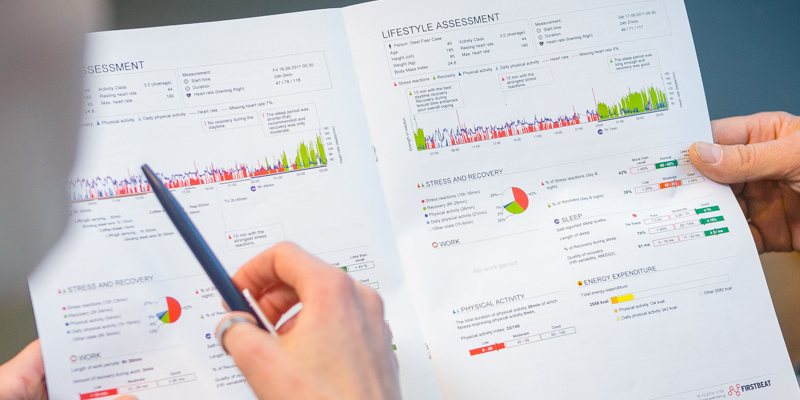
Firstbeat Lifestyle Assessment
Balancing Stress and Recovery: 72-hour HRV Measurement & Analysis
Stress is an important part of our human life. Chronic stress without good recovery, however, reduces a person’s perfomance and wellbeing. It can result in overload, exhaustion and eventually burnout.
The Firstbeat Lifestyle Assessment provides a science-based analysis of
- stress-recovery balance,
- restorative effect of sleep and
- health effect of physical activity.
It can help for developing new habits of self-care and self-regulation.
What is the Firstbeat Lifestyle Assessment?
The Firstbeat Lifestyle Assessment was developed for the professionel analysis of stress and recovery times and the resulting body battery and wellbeing. It analyzes the heart rate variability (HRV). HRV is a good measurement for the body’s reaction to daily activities and situations. There is also a relationship between HRV and performance.
As a result, the Firstbeat Lifestyle Assessment can help in adjusting personal lifestyle for wellbeing and performance. For this purpose the 72-hour HRV measurement is compared to daily activities and situations. The resulting analysis can provide insights into helpful and supportive new routines and behaviors.

Why?
Wellbeing and performance are connected to a person’s capacity to regulate stress through periods of recovery – throughout the day and at night. Proper adjustments to one’s routines and habits can result in improvements to the stress-recovery ratio.
Regulating Stress

The 72-hour-measurement shows situations and circumstances, that trigger increased and/or prolonged stress-activation. Coaching can help in identifying the triggers of stress and provide methods and tools for self-care and self-regulation.
Improving Physical Fitness

One’s overall fitness level impacts both, the body-resources available for stress-regulation as well as one’s ability to self-regulate after stress-activation. The assessment can help in adjusting the physical activities and exercises for improvement.
Intentional Recovery

Peak performance requires adequate recovery. This is similarly true for physical, emotional and mental performance. Quality and quantity of sleep and daily recovery periods are analyzed. Short, selective recovery periods and techniques can generate good and lasting recovery.
How does it work?
The Firstbeat Lifestyle Assessment is done in three simple steps.
Measurement

The Firstbeat Bodyguard, a light-weigt and user-friendly measurement tool, is used for HRV measurement. Daily activities, situations and sleep-times are recorded in an online-journal.
Assessment

After the measurement the tool is returned, data are uploaded and the Lifestyle Assessment generated.
Feedback-Gespräch

Finally, you will receive a 30 minute feedback call. This can also be extended to a full coaching session if you are interested.
The Lifestyle Assessment’s Goals
- Learn to better regulate daily stress by identifying triggers in your job and private life and improving your self-regulation accordingly.
- Improve your bodily-ressources through appropriate movement and exercise.
- Improve recovery (quantity and quality) during the day and during sleep.

